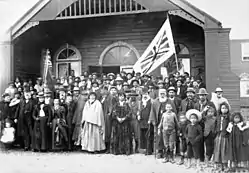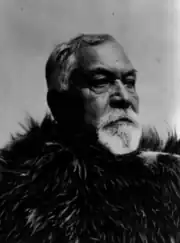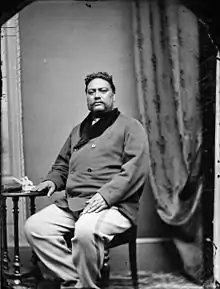Māori Parliament Movement Te Kotahitanga | |
|---|---|
 Flag of the United Tribes of New Zealand | |
| Type | |
| Type | |
| Houses | Te Whare Ariki (Upper House) Te Whare o Raro (Lower House) |
| History | |
| Founded | 14 June 1892 |
| Disbanded | 21 March 1902 |
| Succeeded by | Māori councils |
| Leadership | |
Chairman | |
Speaker | |
Premier | |
| Seats | 140 (1892) 44 (Whare Ariki) 96 (Whare o Raro) |
| Meeting place | |
| Waipatu (1892, 1893), Pākirikiri (1894), Rotorua (1895), Taupō (1896), Pāpāwai (1897, 1898), Rotorua (1900, 1901), Waiōmatatini (1902) | |
The Kotahitanga movement was an autonomous Māori parliament convened annually in New Zealand from 1892 until 1902. Though not recognised by the New Zealand Government, the Māori Parliament was an influential body while it lasted. By 1902 its role was largely superseded by the Māori councils established by James Carroll and Hone Heke Ngapua through the Māori Councils Act 1900. As a result, Kotahitanga members unanimously voted for its dissolution at the 10th Parliament at Waiōmatatini in 1902.
Te Kotahitanga was distinct from Te Kauhanganui, the Māori parliament established by the Kingitanga movement in the late 1880s, because it called for the union of all Māori tribes, whereas Te Kauhanganui was convened by and for the hapū of the Waikato-Tainui region. In 1895 the two movements considered merging, but this ultimately failed.
Sessions
Waipatu 1892
The first formal session of Te Kotahitanga was held in June 1892 at Waipatu in Heretaunga. It was hosted by the former Member of Parliament for the Eastern Maori electorate, Henare Tomoana. 96 representatives sat in the Whare o Raro and 44 chiefs sat in the Whare Ariki. Tomoana was elected Speaker of the House because his tenure in parliament gave him the experience necessary to guide debates and maintain order. Hoani Te Whatahoro Jury was elected chairman, the formal head of the Whare o Raro, and Hamiora Mangakahia was elected premier, a position that made him the chief spokesperson for the movement.


Waipatu 1893
In 1893 the second session of Te Kotahitanga was also convened at Waipatu, though this session was poorly attended. Only 58 representatives sat in the Whare o Raro. At that time, Mangakahia had fallen out of favour with many of the movement's representatives and was not returned as premier. Hoani Te Whatahoro Jury was elected in his place.
Pakirikiri 1894
The 1894 session took place at Pakirikiri, near Gisborne. The session, hosted by local chief Otene Pitau, was well attended and lasted for over a month.
Rotorua 1895
The 1895 session of Te Kotahitanga was convened at Ohinemutu in Rotorua. Hamiora Mangakahia was re-elected for a second term as premier, and the role of speaker was given to Mohi Te Ātahīkoia of Ngāti Kahungunu. In the course of this session, Henare Tomoana accused Mangakahia of financial mismanagement of Te Kotahitanga during his first term as premier, and attempted to force his resignation. But Mangakahia was able to demonstrate in rebuttal that the mismanagement of Kotahitanga funds had actually developed during the term of his successor, Hoani Te Whatahoro Jury.[3] The session is also notable as the setting for a potential merger of Te Kotahitanga with the Kingitanga movement. Mahuta Tāwhiao, the new King of the Waikato-Tainui tribes, was visited by representatives from the 1895 sitting of Te Kotahitanga, who invited him to sign the Kotahitanga deed of union, calling for the political union of all Māori tribes. Mahuta appointed a committee to consider the proposal, but was undermined by Waikato chief Tupu Atanatiu Taingakawa Te Waharoa, who circulated a rival deed of union calling for all Māori tribes to unite under the Kingitanga.


Membership
The lower house, or Whare o Raro, had 96 members, elected at large from electorates defined according to tribal affiliation. The upper house, or Whare Ariki, was composed of 44 paramount chiefs elected by the members of the Whare o Raro. 127 representatives filled the 140 positions in both houses at the parliament's first sitting at Waipatu Marae in 1892, as 13 chiefs were elected to both houses.
Whare o Raro members (1892)
| Constituency | Member | Iwi affiliation | Member's origin | Position |
|---|---|---|---|---|
| Ngāpuhi | Wikiriwhi Hemana | Ngāti Whatua | Kaipara | |
| Muriwai Hepehi | Ngāpuhi, Te Rarawa | Whangaroa | ||
| Kaipo Hotereni | Ngāpuhi, Te Rarawa | Waihou ki te Kauru | ||
| Miti Kakau | Te Rarawa | Hokianga | ||
| Wi Katene | Ngāpuhi | Ōhaeawai, Tautoro | ||
| Maihi Kawiti | Ngāpuhi | Waiomio, Taumarere | ||
| Pomare Kingi | Ngāpuhi | Whatitiri | ||
| Karena Kiwa | Ngāpuhi | Whangaroa | ||
| Taniora Moto | Te Rarawa | Mangamuka | ||
| Eramiha Paikea | Ngāti Whatua | Kaipara | ||
| Ngakuru Pana | Ngāpuhi, Te Rarawa | Waimamaku | ||
| Kereama Papaka | Ngāpuhi | Waikara | ||
| Peri Paraihe | Te Rarawa | Hokianga | ||
| Hemi Parata | Ngāti Whatua | Te Awaroa, Kaipara | ||
| Netana Patuawa | Ngāti Whatua | Opanaki, Maunganui | ||
| Te Kaka Porowini | Ngāpuhi | Te Karetu, Pewhairangi | ||
| Timoti Puhipi | Te Rarawa | Ahipara, Kaitara, Te Awanui | ||
| Pere Riwhi | Ngāpuhi | Whirinaki | ||
| Riwi Taikawa | Ngāpuhi | Whangārei, Kaihou | ||
| Pene Taui | Ngāpuhi | Oromahoe, Waimate | ||
| Heremia Te Wake | Te Rarawa | Hokianga | ||
| Re Te Tai Maunga | Te Rarawa | Hokianga | ||
| Wiki Te Pirihi | Ngāpuhi | Whangārei, Kaihou | ||
| Mitai Titore | Ngāpuhi | Mangakāhia, Ahuahu | ||
| Hemi Tupe | Ngāpuhi | Whangaroa | ||
| Raniera Wharerau | Ngāpuhi | Waima | ||
| Te Paki Wihongi | Ngāpuhi | Kaikohe | ||
| Mohi Wikitahi | Ngāpuhi | Waima | ||
| Te Tai Hauāuru | Hoani Amorangi | Ngāti Raukawa, Muaupoko | ||
| Reha Aperahama | Ngāti Maru | Te Aroha | ||
| Hoani Wiremu Hipango | Ngāti Hau | Whanganui | ||
| Hamiora Mangakahia | Ngāti Whanaua, Ngāti Pare | Whitianga | Premier | |
| Wiremu Ngapaki | Ngāti Ruanui | Hawera, Patea | ||
| Ngarangikatitia-Tutae | Ngāti Ruanui | |||
| Manahi Paewai | Rangitane | Manawatu | ||
| Te Aohau Pungarehu | Ngāti Raukawa | Waikato | ||
| Ropiha Rangihaukori | Ōpunake | |||
| Hamapiri Te Arahori | Ngāti Maniapoto | Ōtorohanga, Te Kūiti | ||
| Wi Te Kākākura | Ngāti Awa | Waitotara, Mokau | ||
| Wiari Te Kuri | Ngāti Maniapoto | Ōtorohanga, Te Kūiti | ||
| Te Manaotawhaki | Ngāti Apa | Manawatu | ||
| Rore Te Rangiheuea | Rangitane | Warupere | ||
| Te Keepa Te Rangihiwinui | Ngāti Awa | Hawera, Taranaki | ||
| E.H. Te Taitea | Ngāti Awa | Te Whanganui-a-Tara | ||
| E.H. Te Taitea | Ngāti Toa | Porirua, Waikanae | ||
| Kipa Te Whatanui | Ngāti Raukawa, Muaupoko | Otaki | ||
| Hamiora Tupaea | Ngai Te Rangi | Tauranga | ||
| Te Tai Rawhiti | Kipa Anaru | Ngāti Kahungunu | Mohaka | |
| Te Makiri Hona | Te Urewera Katoa | Te Waimana | ||
| Hoani Kehua | Ngāti Kahungunu | Wairoa | ||
| Hoani Kerei | Te Whanau-a-Apanui | Whangaparaoa | ||
| Akuhata Kiharoa | Te Arawa | Wairakei, Rotorua | ||
| Wiremu Kupa | Ngāti Kahungunu | Mohaka | ||
| Nepia Mahuika | Ngāti Porou | Waiapu | ||
| Hori Mania | Ngāti Kahungunu | Wairoa | ||
| Tuta Nihoniho | Ngāti Porou | Waiapu | ||
| Wi Pakai | Ngāti Hineuru | |||
| Eruini Paranihi | Ngāti Tuwharetoa | Taupō-nui-a-tia | ||
| Wiremu Potae | Te Aitanga-a-Hauiti | Tolaga Bay | ||
| Timi Rimene | Te Arawa, Ngāti Pikiao | Maketu | ||
| H. Ropiha | Ngāti Kahungunu | Ahuriri, Heretaunga | ||
| Hoani Ruru | Ngāti Kahungunu | Gisborne ki Paritu | ||
| H. M. Tamahau | Ngāti Kahungunu | Wairarapa | ||
| Karaitiana Te Amaru | Te Aitanga-a-Hauiti | Tolaga Bay | ||
| Mohi Te Atahikoia | Ngāti Kahungunu | Wairarapa | ||
| H. Te Aweawe | Ngāti Kahungunu | Ahuriri, Heretaunga | ||
| Apiata Te Hame | Te Aitanga-a-Hauiti | Tolaga Bay | ||
| Hami Te Heru | Ngāti Kahungunu | Te Paritu ki te Kaha-a-Tureia | ||
| Tureiti Te Heuheu Tukino V | Ngāti Tuwharetoa | Taupō-nui-a-tia | ||
| Wi Te Houkamau | Ngāti Porou | Whangaparaoa | ||
| Anaru Te Kakahi | Ngāti Porou | Waiapu | ||
| Aperahama Te Kume | Ngāti Tuwharetoa | Taupō-nui-a-tia | ||
| Maraku Te Rangihirawea | Ngāti Tuwharetoa | Taupō-nui-a-tia | ||
| H. Te Rango | Ngāti Kahungunu | Ahuriri, Heretaunga | ||
| Hoani Te Rohurohu | Ngāti Kahungunu | Gisborne ki Paritu | ||
| Nikora Te Wakaunua | Manawa | Tarawera, Rangitaiki | ||
| Hoani Te Whatahoro Jury | Ngāti Kahungunu | Ahuriri, Heretaunga | Chairman | |
| Rewi Toheriri | Ngāti Kahungunu | Te Paritu ki te Kaha-a-Tureia | ||
| Henare Tomoana | Ngāti Kahungunu | Ahuriri, Heretaunga | Speaker of the House | |
| Hoani Paraone Tunuiarangi | Ngāti Kahungunu | Wairarapa | ||
| Hapimana Tunupaura | Ngāti Kahungunu | Wairoa | ||
| Raniera Turoa | Ngāti Kahungunu | Gisborne ki Paritu | ||
| Hemi Waeka | Ngāti Kahungunu | Gisborne ki Paritu | ||
| Tupara | Te Arawa | Wairakei, Rotorua | ||
| Toha | Ngāti Kahungunu | Wairoa | ||
| Rahurahu | Ngāti Kahungunu | Wairoa | ||
| Netane | Te Urewera Katoa | Ruatoki | ||
| Te Waipounamu | Raniera Erihana | Ngāi Tahu | Waikouaiti | |
| Taituha Hape | Ngāi Tahu | Kaiapoi | ||
| Hoani Maaka | Ngāi Tahu | Kaiapoi | ||
| Wiwi Tairoa | Ngāi Tahu | Arahura, Hauauru | ||
| Timoti Te Whiu | Ngāi Tahu | Wairewa | ||
| Hone Taare Tikao | Ngāi Tahu | Wairewa | ||
| Pita Tipa | Ngāi Tahu | Moerangi | ||
| Paratenei Tunuiarangi | Ngāi Tahu | Kaiapoi | ||
| Taniora Rau | Rangitane, Ngāti Toa | Arapawa | ||
Whare Ariki Members (1892)
| Member | Iwi affiliation |
|---|---|
| Te Keepa Te Rangihiwinui | Ngāti Awa |
| Takarangi Mete Kingi | Ngāti Awa |
| Ropata Te Ao | Ngāti Raukawa |
| Kipa Te Whatanui | Ngāti Raukawa |
| Himona Papaka | Ngāti Tuwharetoa |
| Paora Ngawaha | Ngāti Tuwharetoa |
| Hoani Nahe | Ngāti Maru |
| Pita Tipa | Ngāi Tahu |
| Taiuru | Ngāti Taurawhiti |
| Kingi Te Herekiekie | Ngāti Tuwharetoa |
| Tuakau | Ngāti Tuwharetoa |
| Raihania Takapa | Ngāti Awa |
| Akapita Te We | Ngāi Tūhoe |
| Wi Katene | Ngāpuhi |
| Paratene Tunuiarangi | Ngāi Tahu |
| Hemi Tupe | Ngāpuhi |
| Pomare Kingi | Ngāpuhi |
| Maihi Kawiti | Ngāpuhi |
| Eramiha Paikea | Ngāti Whatua |
| Mitikakau | Te Rarawa |
| Re Te Tai Maunga | Te Rarawa |
| Akuhata Kiharoa | Te Arawa |
| Timoti Puhipi | Te Rarawa |
| Wi Te Houkamau | Ngāti Porou |
| Wiremu Potae | Ngāti Porou |
| Nepia Mahuika | Ngāti Porou |
| Ropata Wahawaha | Ngāti Porou |
| Wi Pere | Ngāti Kahungunu |
| Henare Matua | Ngāti Kahungunu |
| Kerei Te Ota | Ngāti Kahungunu |
| Hami Te Hau | Ngāti Kahungunu |
| Hirini Te Kani | Ngāti Kahungunu |
| Puhara Hawaikirangi | Ngāti Kahungunu |
| Teira Tiakitai | Ngāti Kahungunu |
| Ekengarangi Hapuku | Ngāti Kahungunu |
| Hapuku Te Nahu | Ngāti Kahungunu |
| Paora Ropiha | Ngāti Kahungunu |
| Peni Te Uamairangi | Ngāti Kahungunu |
| Wiremu M. Porotene | Ngāti Kahungunu |
| Wiki Moa Ngamanako | Ngāti Hineuru |
| Ngawaka te Wharehina | Ngāti Hine |
| Piripi Te Maari | Ngāti Kahungunu |
| Tamati M. Te Apatu | Ngāti Kahungunu |
| Hori H. Te Huki | Ngāti Kahungunu |
References
- ↑ Ballara, Angela. "Tomoana, Henare". Dictionary of New Zealand Biography. Ministry for Culture and Heritage. Retrieved 10 September 2014.
- ↑ Ballara, Angela. "Te Atahikoia, Mohi". Dictionary of New Zealand Biography. Ministry for Culture and Heritage. Retrieved 27 November 2015.
- ↑ Ballara, Angela. "Hamiora Mangakahia". Dictionary of New Zealand Biography. Ministry for Culture and Heritage. Retrieved 27 November 2015.